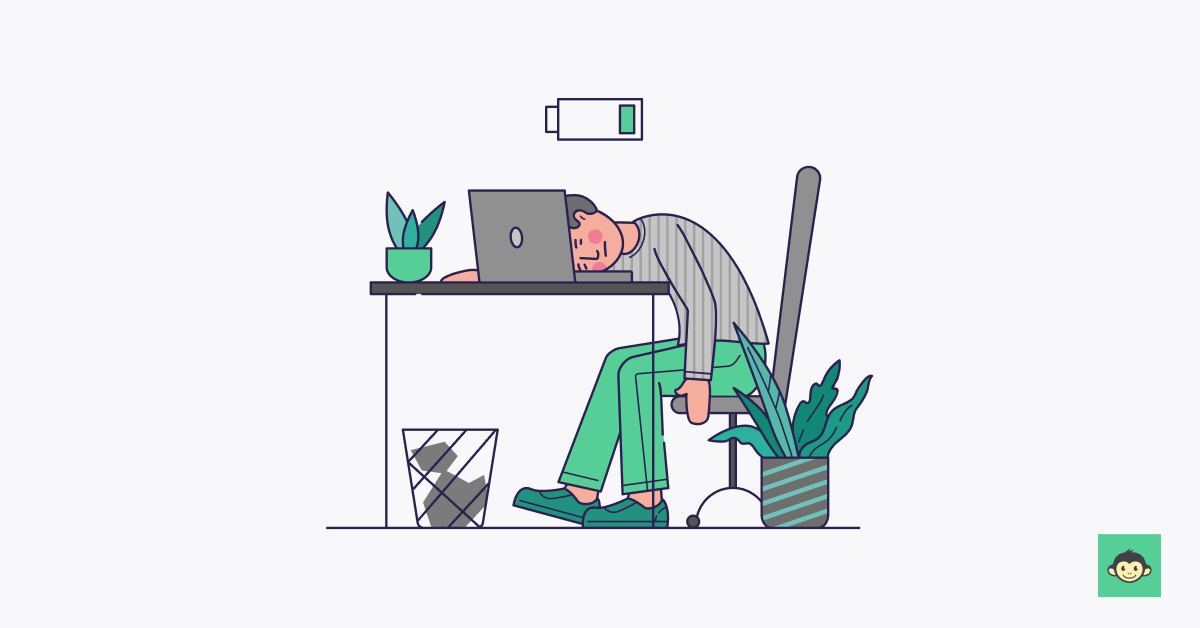How to prevent burnout for your team across industries: Top strategies to try in 2024

Burnout. It's a word we hear thrown around a lot these days, and for good reason. Today, chronic stress, emotional exhaustion and long hours are chipping away at our mental and physical health.
This isn't just a personal struggle – burnout is a real problem in workplaces across all industries, leading to decreased productivity, increased absenteeism, and even employee turnover.
But here's the good news: burnout is preventable. As a leader, you have the power to create a work environment that fosters well-being and protects your team from the negative effects of workplace stress.
We'll delve into the science behind why a person may experience burnout, exploring the early signs and how it can manifest in both physical symptoms and emotional ways.
We'll also discuss the importance of practicing self care and-care, healthy habits like sleep and exercise, and techniques for managing stress effectively.
Why it's high time leadership should pay attention to employee burnout in 2024?

Mental health has been the talk of the town when it comes to workplace environment, but are we doing enough for it as leader? Let’s deep dive into it.
- Mental health matters: The stigma surrounding mental-health problems has gradually diminished over the years, prompting more individuals to speak up about their struggles. However, the pressure to perform, coupled with the relentless pursuit of productivity, has led to a rise in mental health challenges among employees.
- Changing work dynamics: While the new changes brought newfound flexibility, they also blurred the boundaries between work and their personal lives. As a result, employees often find themselves struggling to maintain a healthy work-life balance, leading to increased stress and burnout.
- Retention and engagement: Employee turnover incurs significant costs for organizations, both financially and culturally. Studies have shown that burnout is a leading cause of employee disengagement and turnover. By prioritizing efforts to prevent burnout and foster a supportive work environment, leaders can enhance employee satisfaction and retention rates.
- Productivity and performance: Contrary to popular belief, overworking employees does not equate to higher productivity. In fact, chronic stress and burnout can lead to decreased cognitive function, poor decision-making, and lower job performance.
- Ethical responsibility: Beyond the bottom line, leaders have a moral obligation to prioritize the welfare of their employees. In an era where corporate social responsibility is under scrutiny, organizations are expected to demonstrate a commitment to employee well-being.
- Legal and reputational risks: With increased awareness of workplace mental health issues, organizations face greater scrutiny from regulatory bodies and the public. Failure to address burnout not only exposes companies to legal liabilities but also tarnishes their reputation as employers of choice.
Causes of employee burnout
Employee burnout is a significant concern that can negatively impact productivity, morale, and overall organizational health. Understanding the underlying causes of burnout is crucial for implementing effective prevention strategies. Below are key causes of employee burnout:
- Excessive workload: When employees are consistently overwhelmed with tasks and responsibilities beyond their capacity, it leads to chronic stress. Over time, this excessive workload can result in physical and mental exhaustion, contributing to burnout.
- Lack of control: Employees who feel they have little control over their work, such as not being involved in decision-making or having rigid schedules, often experience higher levels of stress. This lack of autonomy can diminish job satisfaction and lead to burnout.
- Unclear job expectations: Ambiguity in job roles and responsibilities creates confusion and anxiety among employees. When expectations are not clearly defined, employees may struggle to meet demands, leading to frustration and burnout.
- Poor work-life balance: Employees who are unable to maintain a healthy balance between work and personal life are at greater risk of burnout. Continuous work without adequate time for rest and personal activities can lead to emotional and physical depletion.
- Lack of support: A work environment where employees do not receive adequate support from managers or colleagues can contribute to feelings of isolation and burnout. Supportive relationships and a positive workplace culture are essential for maintaining employee well-being.
- Monotony and lack of challenge: Jobs that are monotonous or lack intellectual or creative challenges can lead to disengagement. When employees do not feel stimulated or motivated by their work, they may experience burnout due to a lack of fulfillment.
9 Top challenges we encounter in preventing employee burnout

Addressing employee burnout is crucial for maintaining a healthy and productive workforce. However, preventing burnout comes with its own set of challenges that organizations must navigate effectively.
Understanding and overcoming these obstacles is essential for creating a supportive work environment that promotes employee well-being and organizational success.
1. Physical and mental health
Balancing physical and mental health needs presents a challenge, as individuals must address both aspects to maintain overall well-being. This requires a holistic approach that considers factors such as exercise, nutrition, healthy sleep habits, and stress management.
2. Parental burnout inventory
Identifying and addressing parental burnout can be challenging due to its complex nature and varied contributing factors.
Factors such as work-life balance, childcare responsibilities, societal pressures, and personal expectations can all contribute to parental burnout, making it essential to develop tailored interventions and support systems.
3. Manage stress
Developing effective strategies to manage stress is crucial but can be difficult without proper guidance and resources.
Employees may struggle to identify coping mechanisms that work for them, and organizations may lack the necessary support systems, such as employee assistance programs or stress management workshops, to help employees navigate stress effectively.
4. Avoid burnout
While avoiding burnout is the goal, it's often challenging to recognize the warning signs, and take proactive measures.
Employees may be hesitant to acknowledge their own burnout due to fear of stigma or concerns about job security, while managers may struggle to identify burnout in their team members or implement preventive measures effectively.
5. Stress management techniques
Implementing stress management techniques requires education and training to ensure they are effective and sustainable.
Employees may be unaware of the various techniques available or may struggle to incorporate them into their daily routines without adequate support and guidance from their organization.
6. Burnout
Despite the growing body of research on burnout, translating findings into actionable strategies remains a challenge for many organizations.
While research provides valuable insights into the causes and consequences of burnout, organizations may struggle to implement evidence-based interventions or may lack the resources to conduct their own research to inform their prevention efforts.
7. Job stress
Identifying and mitigating job-related stressors is essential, but it can be challenging without a comprehensive understanding of their origins and impact on employees.
Job stressors can vary widely depending on factors such as job role, organizational culture, workload, and interpersonal dynamics, making it crucial for organizations to conduct thorough assessments and tailor their prevention strategies accordingly.
8. Workplace culture
Cultivating a workplace culture that prioritizes employee well-being can be challenging, particularly in environments with high demands or competitive pressures.
Organizations must balance performance expectations with a culture of support and care, which may require a shift in leadership approaches and company values to prevent burnout effectively.
9. Recognition and rewards
Ensuring that employees feel valued and recognized for their efforts is crucial, yet it can be difficult to implement consistently across an organization.
A lack of appreciation can contribute to burnout, making it essential for companies to develop fair and meaningful recognition programs that reinforce employee engagement and prevent feelings of burnout.
How does employee burnout lead to attrition?

Employee burnout often serves as a catalyst for attrition within organizations, leading to a significant loss of valuable talent.
As individuals grapple with the relentless pressures of the modern workplace, the toll of burnout can manifest in various ways, ultimately driving them to seek opportunities elsewhere.
Impact on physical and mental health
One key factor contributing to attrition is the erosion of job satisfaction stemming from burnout. When employees experience burnout and long term stress often, their engagement and enthusiasm for their work diminish.
Over time, this dissatisfaction can culminate in a desire to leave the organization in search of roles that offer greater fulfillment and work-life balance.
Strained interpersonal relationships
Burnout can strain interpersonal relationships within the workplace, leading to feelings of isolation and disconnection. As a result, employees may feel overwhelmed, undervalued and unsupported, further fueling their decision to seek employment elsewhere.
Organizational culture's role
Moreover, burnout can have detrimental effects on physical and mental health, exacerbating existing health issues and diminishing overall well-being.
In extreme cases, prolonged job burnout can lead to serious health complications like physical exhaustion and even clinical depression, compelling individuals to prioritize their health and seek alternative employment opportunities.
Addressing chronic stress
Furthermore, the organizational culture plays a significant role in how burnout develops, determining whether employees choose to stay or leave. In environments where burnout is normalized or disregarded, employees may feel discouraged from seeking support or speaking out about their struggles.
Conversely, organizations that prioritize employee well-being and proactively address burnout are more likely to retain their workforce.
Consequences of burnout at work for employees
Burnout at work is a pervasive issue that can have severe consequences for employees, affecting both their professional and personal lives. Understanding these consequences is essential for organizations to address and mitigate burnout effectively. Below are key consequences of burnout at work:
- Decline in productivity: Burnout often leads to a significant drop in productivity. Employees who are mentally and physically exhausted struggle to maintain focus and efficiency, resulting in lower output and quality of work.
- Increased absenteeism: Chronic burnout can lead to frequent absenteeism as employees take time off to recover from stress-related illnesses or mental fatigue. This not only impacts individual performance but also places additional strain on the team.
- Mental health issues: Prolonged exposure to stress and burnout can contribute to severe mental health issues such as anxiety, depression, and emotional exhaustion. These conditions can impair an employee's ability to function effectively at work and in their personal life.
- Physical health problems: Burnout is not just a mental health issue; it also has physical health implications. Chronic stress can lead to conditions such as high blood pressure, heart disease, and a weakened immune system, making employees more susceptible to illness.
- Reduced job satisfaction: Employees experiencing burnout often feel disconnected and disengaged from their work, leading to a significant decline in job satisfaction. This dissatisfaction can further exacerbate burnout, creating a vicious cycle.
- Higher turnover rates: When employees face burnout without adequate support or intervention, they are more likely to leave the organization. High turnover rates can be costly for businesses, leading to the loss of talent and increased recruitment and training expenses.
How to prevent burnout at work: 15 Best practices to try

Preventing burnout is essential for maintaining employee well-being and productivity. Implementing effective strategies can help create a supportive workplace culture that fosters resilience and prevents burnout. Here are 15 best practices to try:
- Regular check-ins and feedback sessions: Schedule regular check-ins between managers and employees to discuss workload, challenges, and progress. Providing constructive feedback and support can help employees feel valued and prevent feelings of overwhelm.
- Flexible work arrangements: Offer flexible work arrangements, such as telecommuting or flexible hours, to accommodate employees' individual needs and preferences. Flexibility can empower employees to manage their work-life balance better and reduce stress. In times of high stress or high workload volume, supporting employees in taking a mental health day can combat concerns about perception.
- Encourage boundaries: Encourage employees to set boundaries between work and personal life. Encourage them to disconnect from work emails and calls outside of working hours to promote relaxation and recharge.
- Promote mindfulness practices: Introduce mindfulness practices, such as meditation or yoga sessions, to help employees manage stress and enhance focus. Providing access to mindfulness resources can empower employees to cope with challenging situations more effectively.
- Recognition and appreciation: Regularly recognize and appreciate employees' efforts and achievements. Celebrate milestones, accomplishments, and contributions publicly to boost morale and motivation.
- Career development opportunities: Provide opportunities for skill development and career growth. Offering training programs, mentorship opportunities, and advancement pathways can increase job satisfaction and engagement, reducing the risk of burnout.
- Encourage time off: Encourage employees to take regular breaks and utilize their vacation time. Promote a culture where taking time off is not only encouraged but also celebrated as essential for maintaining well-being and performance.
- Promote social connections: Foster a sense of community and belonging among employees by organizing team-building activities, social events, or virtual gatherings. Strong social connections can provide emotional support and resilience against burnout.
- Offer employee assistance programs (EAPs): Provide access to Employee Assistance Programs (EAPs) that offer counseling, mental health support, and resources for managing personal and work-related challenges.
- Promote healthy habits: Encourage employees to prioritize their physical health by promoting healthy habits such as regular exercise, nutritious eating, and enough sleep. Physical well-being is closely linked to mental resilience and can help prevent burnout.
- Clear communication channels: Establish clear communication channels to ensure that employees feel heard and supported. Encourage open dialogue, address concerns promptly, and provide regular updates on organizational changes or developments.
- Empowerment and autonomy: Empower employees with autonomy and decision-making authority over their work. Allowing them to have control and ownership fosters a sense of responsibility and engagement, reducing the risk of burnout.
- Promote a positive work environment: Foster a positive work environment characterized by trust, respect, and collaboration. Address toxic behaviors or negative attitudes promptly and cultivate a culture of kindness and appreciation.
- Manage workload effectively: Ensure that workloads are manageable and aligned with employees' capacities. Regularly assess and adjust tasks to prevent overburdening employees, which can lead to burnout. Encourage managers to delegate tasks appropriately and provide resources or additional support when needed.
- Foster open communication: Encourage a culture of open communication where employees feel comfortable discussing their stress levels and workload challenges without fear of judgment. Establish anonymous feedback channels or regular surveys to gauge employee well-being and make necessary adjustments to prevent burnout.
How to prevent burnout for remote employees: 10 Tips

Burnout amongst remote employees is real. Preventing and reducing burnout among remote workers requires thoughtful strategies and support systems.
Here are practical tips to help organizations overcome burnout and create a supportive environment that fosters work-life balance, resilience, and overall employee satisfaction.
- Encourage regular breaks: Remind remote employees to take regular breaks throughout the day to rest and recharge. Encouraging short breaks can help prevent burnout by allowing employees to step away from their screens and engage in activities that promote relaxation and mental well-being.
- Provide adequate support: Ensure that remote employees have access to the resources and support they need to effectively manage their workload. Offer training, tools, and guidance to help them navigate challenges and overcome obstacles, reducing the risk of burnout due to feeling overwhelmed or unsupported.
- Promote social connections: Foster a sense of community among remote employees by organizing virtual team meetings, collaborative projects, or social events. Encouraging social interactions can help combat feelings of isolation and loneliness, which are common contributors to burnout among remote workers.
- Encourage physical activity: Promote regular physical activity among remote employees to support their overall well-being and mental health. Encourage them to incorporate exercise into their daily routines, whether it's through at-home workouts, outdoor activities, or virtual fitness classes.
- Facilitate communication: Establish effective communication channels to keep remote employees informed, engaged, and connected with their colleagues and supervisors. Encourage regular check-ins, team meetings, and one-on-one discussions to provide support, feedback, and opportunities for collaboration.
- Promote self-care: Encourage remote employees to prioritize self-care and well-being by practicing mindfulness, stress management techniques, and other self-care activities. Provide resources and information on healthy coping strategies and encourage employees to take time for themselves to prevent burnout and maintain resilience.
- Set clear boundaries: Encourage remote employees to establish clear boundaries between work and personal life. This includes setting specific work hours and creating a designated workspace to help them mentally separate work from home life, reducing the risk of burnout.
- Offer flexibility: Provide remote employees with flexibility in their work schedules. Allowing them to adjust their work hours to fit their personal lives can help alleviate stress and prevent burnout, especially for those juggling family responsibilities or other commitments.
- Recognize and reward efforts: Regularly acknowledge and reward the hard work of remote employees. Public recognition and rewards, whether through virtual shout-outs or tangible incentives, can boost morale and motivation, helping to prevent feelings of burnout and disengagement.
- Monitor workload: Keep an eye on remote employees' workloads to ensure they are manageable. Regularly check in to assess whether they are feeling overwhelmed and offer support or adjustments as needed to prevent burnout from excessive demands.
How to prevent burnout in traditional industries?

Let's delve into sector-specific strategies for a stress response fostering a healthy work environment.
Healthcare industry
- Implement staffing strategies: Ensure adequate staffing levels to distribute workloads evenly and prevent burnout. Use predictive analytics to anticipate busy periods and adjust staffing accordingly.
- Provide mental health support: Offer counseling services, support groups, and access to mental health resources to help healthcare workers cope with stress and trauma.
- Promote work-life balance: Implement flexible scheduling options and encourage employees to take regular breaks to rest and recharge.
- Recognize and reward: Recognize healthcare workers for their hard work and dedication through rewards, incentives, and acknowledgment programs.
- Foster team collaboration: Encourage collaboration and teamwork among healthcare staff to share responsibilities and provide mutual support.
Manufacturing industry:
- Ergonomic workstations: Design ergonomic workstations to minimize physical strain and reduce the risk of injuries and fatigue among manufacturing workers.
- Rotate tasks: Implement job rotation programs to prevent monotony and reduce the risk of repetitive stress injuries. Rotating tasks also allows employees to develop new skills and interests.
- Provide training and development: Offer training programs to enhance employees' skills and knowledge, empowering them to perform their jobs more efficiently and effectively.
- Offer wellness programs: Provide wellness programs that promote healthy habits, such as exercise, nutrition, and stress management, to improve overall well-being and reduce burnout.
- Encourage open communication: Create an environment where manufacturing workers feel comfortable sharing concerns and feedback. Addressing issues promptly can help prevent burnout and improve morale.
Hospitality industry:
- Manage workload: Monitor and manage employee workloads to prevent burnout, especially during peak seasons. Implement strategies such as flexible scheduling and cross-training to distribute tasks effectively.
- Foster a positive work environment: Cultivate a positive and supportive workplace culture where employees feel valued, respected, and appreciated.
- Offer employee benefits: Provide comprehensive benefits packages, including health insurance, paid time off, and employee assistance programs, to support employee well-being.
- Provide opportunities for advancement: Offer career development opportunities, such as training programs and advancement pathways, to motivate and retain hospitality employees.
- Promote work-life balance: Encourage employees to take breaks, use their vacation time, and prioritize their personal well-being to prevent burnout and maintain job satisfaction.
Construction industry:
- Ensure safety protocols: Prioritize safety in the workplace by implementing strict safety protocols, providing proper training, and regularly inspecting equipment and work areas.
- Break up monotonous tasks: Break up long and monotonous tasks into smaller, more manageable segments to prevent physical and mental fatigue among construction workers.
- Provide adequate rest areas: Create designated rest areas on construction sites where workers can take breaks, hydrate, and recharge before returning to work.
- Offer support services: Provide access to support services such as counseling, peer support groups, and other mental health professional resources to help construction workers cope with stress and traumatic incidents.
- Promote teamwork and camaraderie: Foster a sense of camaraderie and teamwork among construction workers to provide mutual support and encouragement, reducing feelings of isolation and burnout.
Food & beverages industry:
- Implement efficient workflows: Streamline processes and workflows to minimize bottlenecks and reduce stress for food and beverage industry workers.
- Provide training on stress management: Offer training sessions on stress management techniques, such as mindfulness and relaxation exercises, to help employees cope with the fast-paced nature of the industry.
- Encourage breaks and hydration: Encourage employees to take regular breaks to rest, hydrate, and refuel. Providing access to water stations and nutritious snacks can help employees stay energized and prevent burnout.
- Support work-life balance: Implement flexible scheduling options and provide opportunities for employees to request time off for personal reasons. Supporting work-life balance can help prevent burnout and improve employee retention.
- Recognize and reward performance: Recognize employees for their hard work and dedication through rewards, incentives, and acknowledgment programs. Showing appreciation can boost morale and reduce the risk of burnout in the food and beverage industry.
Conclusion
Deep breath! It's important to recognize that preventing burnout requires a multifaceted approach that considers various factors impacting mental health and well-being.
While there is no one-size-fits-all solution, prioritizing strategies such as promoting work-life balance, implementing effective stress management techniques, and fostering open communication can significantly mitigate the risk of experiencing burnout.
Encouraging regular exercise, adequate sleep, and healthy eating habits are also crucial elements in maintaining overall well-being. Additionally, recognizing the early signs of burnout and providing support for mental health issues are essential aspects of creating a supportive work environment.
By addressing these factors and prioritizing employee well-being, organizations can cultivate a culture that supports resilience and prevents burnout, ultimately leading to healthier, happier, and more productive teams. Reach out to CultureMonkey for more assistance; we know how to check in with your employees the right way.
FAQs
1. How important is work-life balance in preventing burnout?
Work-life balance is crucial in preventing burnout as it allows employees to recharge and separate their personal lives from work. When employees have time to rest and pursue personal interests, they’re less likely to experience chronic stress, leading to better mental health, increased productivity, and long-term job satisfaction.
2. What role does physical health play in preventing burnout?
Physical health plays a significant role in preventing burnout. Regular exercise, proper nutrition, and sufficient sleep help maintain energy levels, reduce stress, and improve overall well-being. Physically healthy employees are more resilient, better equipped to handle work-related pressures, and less likely to experience the emotional exhaustion that leads to burnout.
3. How can employers help prevent burnout among employees?
Employers can prevent burnout by promoting a supportive work environment that includes manageable workloads, regular breaks, flexible work options, and clear communication. Providing resources for stress management, encouraging time off, and recognizing employees' efforts also contribute to reducing burnout, fostering a culture where employees feel valued and supported.
4. How can remote workers prevent burnout?
Remote workers can prevent burnout by setting clear work-life boundaries, taking regular breaks, staying physically active, and maintaining social connections. Establishing a dedicated workspace, sticking to a routine, and engaging in self-care activities like mindfulness or hobbies can also help manage stress and maintain mental well-being while working remotely.
5. Can setting boundaries at work help prevent burnout?
Yes, setting boundaries at work is essential for preventing burnout. Boundaries help employees manage their time, avoid overcommitment, and maintain a healthy work-life balance. By clearly defining when work ends and personal time begins, employees can reduce stress, prevent exhaustion, and protect their mental and physical health.



